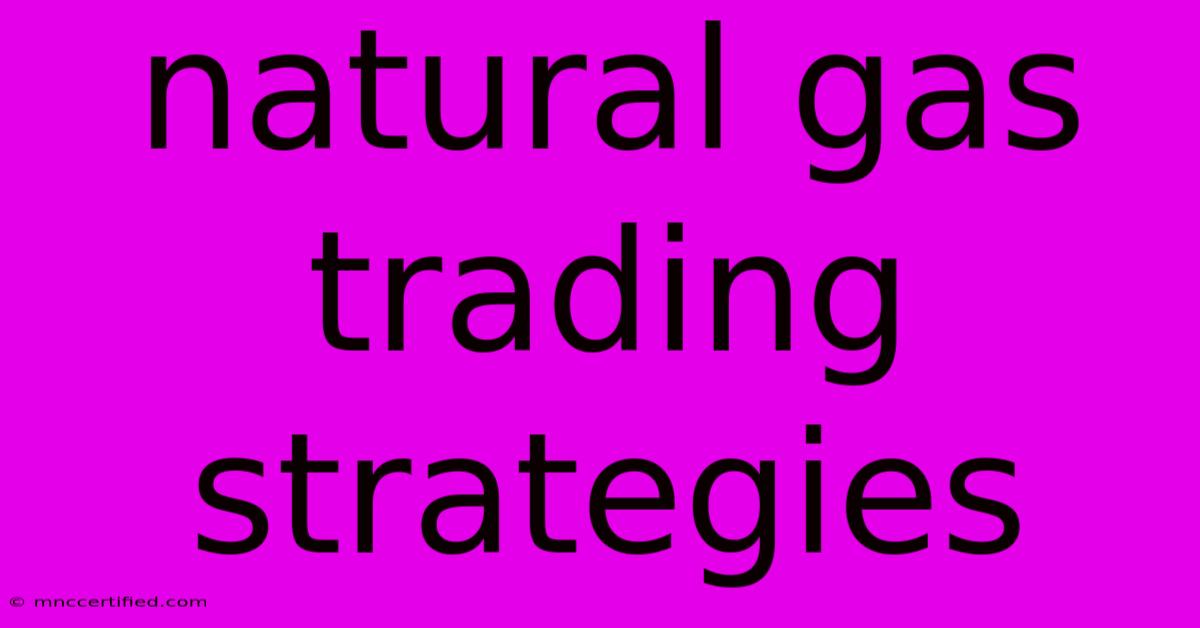Natural Gas Trading Strategies

Table of Contents
Natural Gas Trading Strategies: A Comprehensive Guide for Beginners and Experts
Natural gas, a crucial energy commodity, presents lucrative trading opportunities for both novice and seasoned investors. However, successfully navigating the natural gas market requires a deep understanding of its dynamics and the implementation of effective trading strategies. This comprehensive guide delves into various natural gas trading strategies, covering fundamental and technical analysis, risk management, and considerations for different market conditions.
Understanding the Natural Gas Market
Before diving into specific strategies, it's crucial to grasp the factors influencing natural gas prices. These include:
-
Weather patterns: Extreme cold or heat significantly impact demand, driving prices up or down. A harsh winter, for example, boosts heating demand, leading to price increases. Conversely, a mild winter can depress prices. This is arguably the most significant factor affecting natural gas prices.
-
Supply and demand: The balance between natural gas production and consumption directly affects prices. Increased production can lead to lower prices, while tight supply can drive prices higher. Pay close attention to production data from key regions like the US, Russia, and Canada.
-
Geopolitical events: Global political instability, sanctions, and conflicts can disrupt supply chains and influence prices dramatically. Keep an eye on international news affecting major gas-producing and consuming nations.
-
Economic growth: Strong economic growth generally translates to higher energy consumption and increased natural gas demand, potentially leading to price increases. Conversely, economic slowdowns can reduce demand and put downward pressure on prices.
-
Storage levels: Natural gas storage levels provide insights into future supply and demand. Low storage levels suggest potential price increases, while high storage levels indicate ample supply and potential price decreases. Monitor storage reports closely.
-
Government regulations: Changes in environmental regulations or government policies regarding energy production and consumption can have a significant impact on natural gas prices.
Natural Gas Trading Strategies: A Detailed Look
Several trading strategies can be applied to the natural gas market. The optimal choice depends on your risk tolerance, trading style, and market outlook.
1. Fundamental Analysis
Fundamental analysis focuses on the underlying economic factors affecting natural gas prices. Traders using this approach analyze supply and demand dynamics, weather forecasts, geopolitical events, and storage levels to predict price movements. This is a long-term strategy, suitable for those comfortable with holding positions for extended periods.
2. Technical Analysis
Technical analysis utilizes charts and indicators to identify trends and patterns in natural gas price movements. Traders employing this approach analyze price action, volume, and various technical indicators (such as moving averages, RSI, MACD) to predict future price movements. This allows for both short-term and long-term trading opportunities. Popular technical indicators for natural gas trading include:
- Moving Averages: Identify trends and potential support/resistance levels.
- Relative Strength Index (RSI): Measures the magnitude of recent price changes to evaluate overbought or oversold conditions.
- Moving Average Convergence Divergence (MACD): Identifies momentum changes and potential trend reversals.
3. Seasonal Trading
Natural gas prices often exhibit seasonal patterns. Demand peaks during the winter heating season and troughs during the summer. Seasonal trading involves exploiting these predictable price fluctuations. This strategy requires understanding the historical price behavior and anticipating seasonal demand shifts.
4. Spread Trading
Spread trading involves taking simultaneous long and short positions in related natural gas contracts (e.g., different delivery months). This strategy aims to profit from the price difference between these contracts, minimizing exposure to overall market movements.
5. Option Trading
Option trading offers leveraged exposure to natural gas price movements. Call options allow you to profit from price increases, while put options offer protection against price declines. Option trading can be complex and requires a thorough understanding of option pricing and risk management.
Risk Management in Natural Gas Trading
Regardless of your chosen strategy, effective risk management is paramount. Consider these key aspects:
- Position sizing: Never risk more than a small percentage of your trading capital on any single trade.
- Stop-loss orders: Use stop-loss orders to limit potential losses if the market moves against your position.
- Diversification: Diversify your trading across different strategies and contracts to reduce overall risk.
- Regular monitoring: Actively monitor your positions and adjust your strategy as needed.
Conclusion: Mastering Natural Gas Trading
Successful natural gas trading requires a combination of thorough market analysis, well-defined trading strategies, and disciplined risk management. By carefully considering the factors influencing natural gas prices and employing appropriate strategies, you can increase your chances of achieving profitable outcomes. Remember that trading involves significant risk, and losses are possible. Always conduct thorough research and consider seeking advice from a qualified financial advisor before making any investment decisions.

Thank you for visiting our website wich cover about Natural Gas Trading Strategies. We hope the information provided has been useful to you. Feel free to contact us if you have any questions or need further assistance. See you next time and dont miss to bookmark.
Featured Posts
-
Alpine Scout Camp Trading Post
Nov 28, 2024
-
Liverpool Left Back Tsimikas Injured
Nov 28, 2024
-
Belgian Press On Celtic Volcano Bees
Nov 28, 2024
-
Mishal Husain News Presenter Bbc
Nov 28, 2024
-
Lebanon Ceasefire Displaced Return Home
Nov 28, 2024